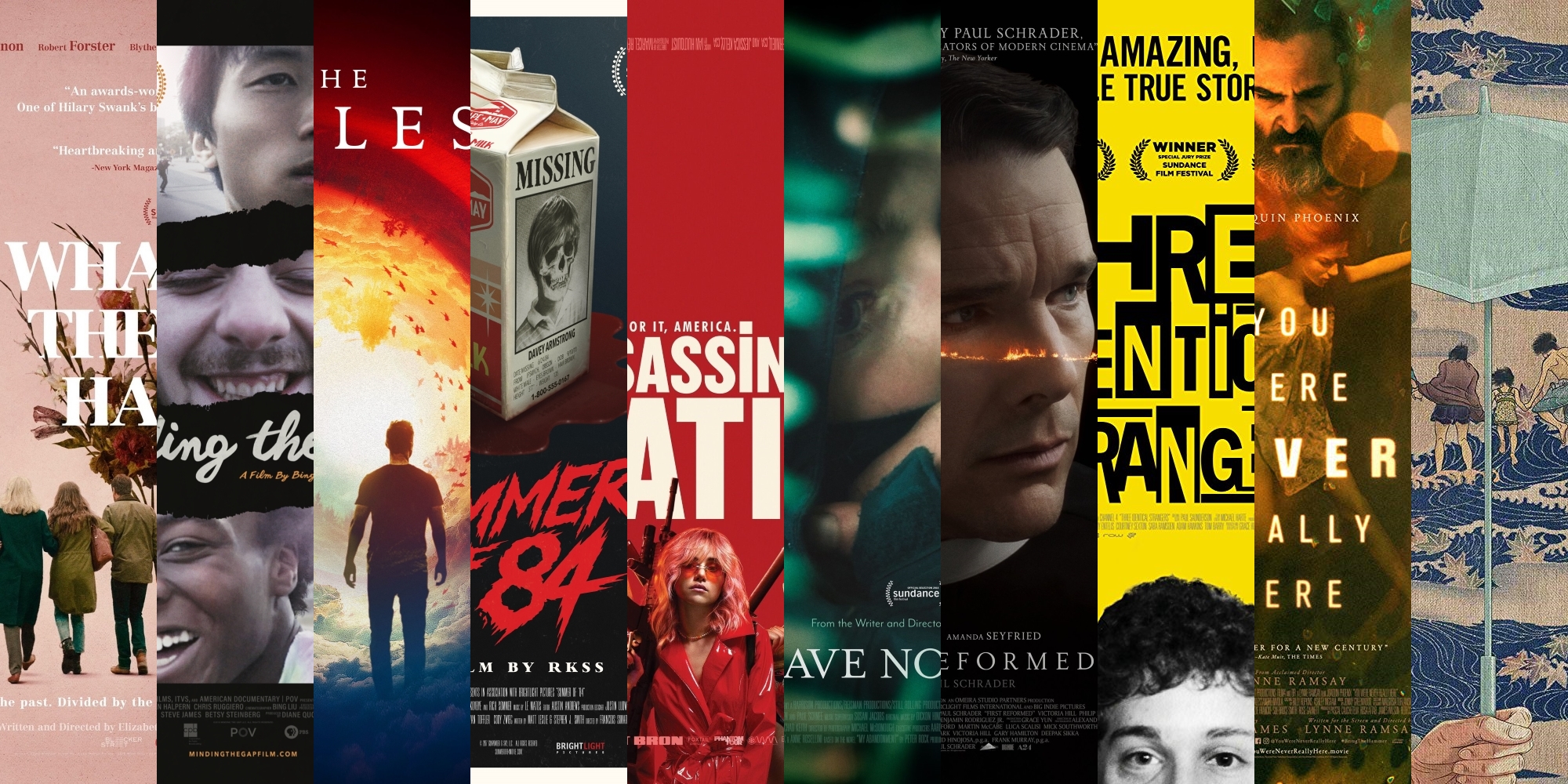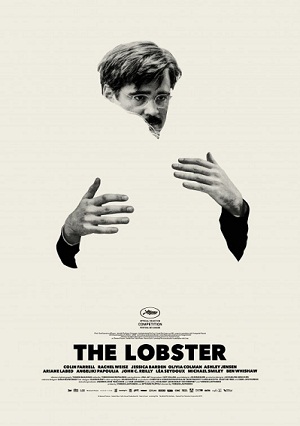 Yorgos Lanthimos’ seventh directorial feature, The Lobster, is a compulsive critique on societal expectations often assigned to an individual’s relationship status. It’s a dark comedy that is as neurotic as its Greek director (see Dogtooth and The Killing of a Sacred Deer). In Lanthimos’ ghastly, fictional world, it is against the law to be single. Those who are, be it by divorce, death, or their inability to find “the one,” are forced into a rehabilitation center located on the outskirts of society. When a guest is admitted, they participate in a 45 day program that is supposedly designed to enhance their search for a soulmate. However, if they fail to find their soulmate within the 45 day window, they are turned into an animal of their choosing and set loose to live out the rest of their days roaming the wild. It’s a bizarre satire of the cultural idealism which has hypothesized that individuals are not only more content, but made complete, when they are in a romantic relationship. In The Lobster, achieving relational wholeness is an individual’s only way to receive bureaucratic asylum.
Yorgos Lanthimos’ seventh directorial feature, The Lobster, is a compulsive critique on societal expectations often assigned to an individual’s relationship status. It’s a dark comedy that is as neurotic as its Greek director (see Dogtooth and The Killing of a Sacred Deer). In Lanthimos’ ghastly, fictional world, it is against the law to be single. Those who are, be it by divorce, death, or their inability to find “the one,” are forced into a rehabilitation center located on the outskirts of society. When a guest is admitted, they participate in a 45 day program that is supposedly designed to enhance their search for a soulmate. However, if they fail to find their soulmate within the 45 day window, they are turned into an animal of their choosing and set loose to live out the rest of their days roaming the wild. It’s a bizarre satire of the cultural idealism which has hypothesized that individuals are not only more content, but made complete, when they are in a romantic relationship. In The Lobster, achieving relational wholeness is an individual’s only way to receive bureaucratic asylum.
In the film’s first act, David (Colin Farrell) checks into one of these rehabilitation centers after learning of his wife’s infidelity. An atypical punishment that castigates David, the cheated on, rather than his wife, the cheater. When David checks in to the center, he is asked a series of very personal questions–not far from the likes of those one may see on a dating website. The center has lavish facilities and amenities, like an indoor, olympic-sized swimming pool, acres of beautiful landscape, and activities designed to integrate its occupants. Yet it is apparent these niceties are not provided for enjoyment rather they exist as necessary appliances for relational direction. Residents are provided with only necessary items: four identical grey trousers, four white and blue oxfords, a belt, a striped tie, socks, underwear, a blazer, and a white bathrobe. They exist within the center’s premise and law and, if they step outside of either, they receive remorseless punishment. This institution is designed to dictate the human experience; maintaining that emotions are kept in line and on the correct track.
Mark Romanek’s 2010 Never Let Me Go–an adaptation of Kazuo Ishiguro’s 2005 novel by famed Ex Machina and Annihilation writer and director Alex Garland–flew a bit under the radar, which is a shame because it’s a damn fine film. (Roger Ebert even awarded it 4 out of 4 stars). It features a bevy of talented young actors right on the cusp of becoming stars (Carey Mulligan, Andrew Garfield, Domhnall Gleeson, Keira Knightley) whose performances are key to focusing the film on the subject at hand.
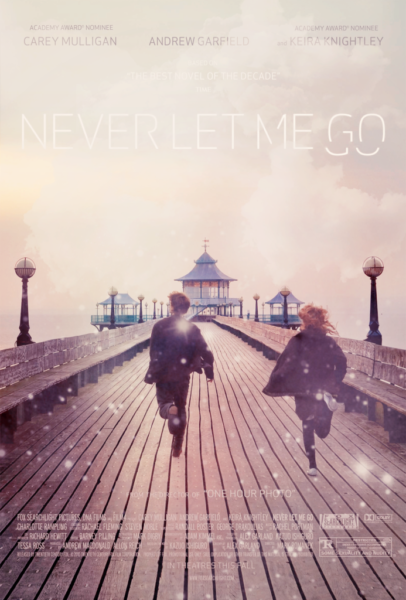 Like The Lobster, NLMG takes place in a strange, dystopian world. In Ishiguro’s world a medical breakthrough in the early 1950’s made it possible for humans to extend their average life expectancy to well beyond 100 years. As a result, a meta civilization is introduced into the world: cloned human beings (children to young adults) who are raised like free-range chickens. Their sole purpose in life is to nurture their bodies so that, once they are of age, they can donate their organs to a person in need who likely belongs to a high social class. They are called “Donors” and they are raised to die.
Like The Lobster, NLMG takes place in a strange, dystopian world. In Ishiguro’s world a medical breakthrough in the early 1950’s made it possible for humans to extend their average life expectancy to well beyond 100 years. As a result, a meta civilization is introduced into the world: cloned human beings (children to young adults) who are raised like free-range chickens. Their sole purpose in life is to nurture their bodies so that, once they are of age, they can donate their organs to a person in need who likely belongs to a high social class. They are called “Donors” and they are raised to die.
We meet the Donors as children early on in the film. Kathy, Tommy, and Ruth–who Mulligan, Garfield, and Knightley play as adults–are students at a boarding school for Donor children called Hailsham. While at Hailsham, the children (and the audience to some extent) are oblivious to their sole purpose in life: to be sacrificed for others. We see children. We learn their character traits. We meet them as humans before we learn that their world does not view them as such. Kathy is empathetic and deeply caring. Tommy is sensitive and anxious and prone to fits of rage. Then there’s Ruth, whose snooty superiority complex obscures her deep-seated jealousy towards Kathy and Tommy’s intimacy. At Hailsham, the students are encouraged to express themselves through art and incentivized by the contingency of having their art selected for “The Gallery.” The reward of being selected for “The Gallery” is as mysterious to them as the purpose of their lives. They only know that a selection would give them something to boast about.
Late in the film’s first act, Kathy, Tommy, and Ruth finally do learn that their organs are to be harvested at the peak of their lives and they are to die young. The intentions of “The Gallery” become more puzzling, while also losing whatever value it may have previously held.
In The Lobster, when asked what animal he’d like to be turned into if he fails to find love, David requests to become a lobster. “Because lobsters live for over one hundred years, are blue-blooded like aristocrats, and stay fertile all their lives. I also like the sea very much.” David’s response, while calculated and precise, is 100% dictated by the accepted norms of modern society. He wishes to live long, live comfortably, produce offspring, and enjoy life. The hotel manager (Olivia Colman) applauds David’s choice for his cleverness. While a lobster may not represent the traditional choice, David’s reasoning for choosing the crustacean communicates that he has fully accepted the standards of his environment. If he is to fail, he’d like to mimic as much of his current world as possible in the next one. Perhaps this is why the hotel manager is so enamoured with his choice: it confirms the principle that her institution seeks to enforce.
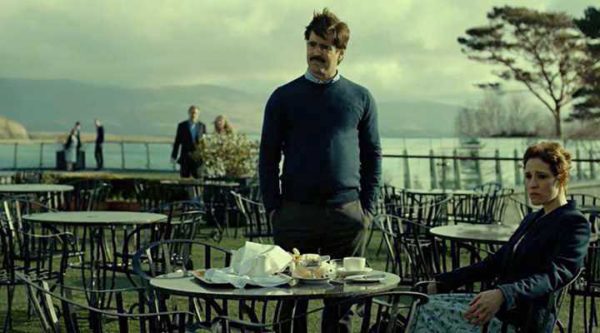 The participants in the program search for romance primarily through “defining characteristics” which are mostly presented as physical ailment. For example, one of the hotel’s residents suffers from frequent nosebleeds, so her ideal mate should also be prone to epistaxis. Their shallow premise for love is also an annotation on the silly nature that often possesses anyone who’s ever looked for love; how the lion’s share of our pilgrimage often zeros in on traits that are trivial at best, like getting excited about finding a fellow nosebleeder. The compelling qualities of love are more eloquent, but perhaps less exciting thus reduced. Nearly all of The Lobster’s dialogue is monotone and direct which reflects the seriousness of the objective at hand. Love, in this world, is purely pragmatic; a wonderless void of self-help.
The participants in the program search for romance primarily through “defining characteristics” which are mostly presented as physical ailment. For example, one of the hotel’s residents suffers from frequent nosebleeds, so her ideal mate should also be prone to epistaxis. Their shallow premise for love is also an annotation on the silly nature that often possesses anyone who’s ever looked for love; how the lion’s share of our pilgrimage often zeros in on traits that are trivial at best, like getting excited about finding a fellow nosebleeder. The compelling qualities of love are more eloquent, but perhaps less exciting thus reduced. Nearly all of The Lobster’s dialogue is monotone and direct which reflects the seriousness of the objective at hand. Love, in this world, is purely pragmatic; a wonderless void of self-help.
David does not succeed at finding love. He does, however, attempt to manipulate it. Realizing that being “fake-in-love” is more sensible than being transformed into a lobster, he pretends to be cruel in order to match with a woman who is described to have no emotion at all. But the law of the land is too boundless and once his faux mate finds out, she seeks to unveil his sins and sentence him to immediate animal conversion. With the help of a rogue hotel employ, David is able to escape his condemnation, fleeing to the woods, where a colony of single refugees live amongst the animals who were once their peers: the “Loners”. He will soon find out that the life of the loner offers as much grace as the 45 day, mate-finding program did. Its laws are just as many. It’s punishments just as ruthless.
 After Kathy, Ruth, and Tommy learn about their definitive fate, Ruth latches onto Tommy, even though she is well aware of her best friend Kathy’s amorous feelings towards Tommy. Ruth’s fear of living out the rest of her short life alone is more powerful than her devotion to Kathy. When the trio turn 18, they are moved from Hailsham to “The Cottages”. Ruth and Tommy still going strong. The Cottages are purgatory homes for donors. A place where they can wait comfortably until they are drafted to begin dying. They are, however, finally given some personal freedom: allowed to engage with pop-culture and even permitted to travel into town, occasionally, to experience the nuances of a normal life: drink sodas and eat garbage like a normal 18-year-old. But these tastes of freedom are cruel, like dangling a t-bone steak in the corridors of the Humane Society. It’s a mere reminder of what they will never have.
After Kathy, Ruth, and Tommy learn about their definitive fate, Ruth latches onto Tommy, even though she is well aware of her best friend Kathy’s amorous feelings towards Tommy. Ruth’s fear of living out the rest of her short life alone is more powerful than her devotion to Kathy. When the trio turn 18, they are moved from Hailsham to “The Cottages”. Ruth and Tommy still going strong. The Cottages are purgatory homes for donors. A place where they can wait comfortably until they are drafted to begin dying. They are, however, finally given some personal freedom: allowed to engage with pop-culture and even permitted to travel into town, occasionally, to experience the nuances of a normal life: drink sodas and eat garbage like a normal 18-year-old. But these tastes of freedom are cruel, like dangling a t-bone steak in the corridors of the Humane Society. It’s a mere reminder of what they will never have.
However, it is here, at The Cottages, where they hear a rumor: if two donors are able to prove that they have fallen in love–true love–then it is possible for them to be gifted a few donor-free years to enjoy their lives together. Whether the rumor is true or Donor-folklore established from the urgent need of hope, it does seem to alleviate their despair. The drawback, notwithstanding, is that the love must prove to be true, not contrived. The only truth that the donors have ever known is that they live to die; to be sacrificed. Now, after living most of their lives with their necks in the noose, they must define and present love. Kathy, Tommy, and Ruth remember “The Gallery”. They remember how they were encouraged to express themselves through art, and realize it was the only time that they were ever encouraged to express much of anything. Naturally, they link their expressions of art to their ability to prove that they have souls capable of love. For Ruth and Tommy, this new revelation is simultaneously invigorating and problematic. While they’ve been together for many years, Ruth knows that their relationship was born out of fear and jealousy, and Tommy knows that he has always been connected to Kathy. The hope of love offers a new anxiety and it’s these driving forces that splinters the trio’s friendship when they enter into the donation phase of their lives.
 The Loner lifestyle presented in The Lobster is proud. The Loners are unapologetic about their singleness, adamant that their independence represents integrity not inadequacy. A Loner’s singleness is their defining characteristic, and it must remain sacred. The leader of the Loners, played fiercely by Lea Seydoux, is a merciless enforcer of the law. David’s new community is no more of a refuge than the one he just left, but he seems to accept the creeds of the Loners as readily as he did the notion that he deserved to be transformed into an animal. David’s willingness to reshape his ideals without question is a survival tactic and it speaks to humankind’s need for systemic structure. Even if it means shifting from one extreme to another in the matter of minutes. The boundaries of the systems David so wishes to live between are constantly threatened by his authentic self. Ironically, David was unable to find love, or something that could pose as it, in an environment where it was required, but amongst the Loner community, stumbles upon it unwittingly.
The Loner lifestyle presented in The Lobster is proud. The Loners are unapologetic about their singleness, adamant that their independence represents integrity not inadequacy. A Loner’s singleness is their defining characteristic, and it must remain sacred. The leader of the Loners, played fiercely by Lea Seydoux, is a merciless enforcer of the law. David’s new community is no more of a refuge than the one he just left, but he seems to accept the creeds of the Loners as readily as he did the notion that he deserved to be transformed into an animal. David’s willingness to reshape his ideals without question is a survival tactic and it speaks to humankind’s need for systemic structure. Even if it means shifting from one extreme to another in the matter of minutes. The boundaries of the systems David so wishes to live between are constantly threatened by his authentic self. Ironically, David was unable to find love, or something that could pose as it, in an environment where it was required, but amongst the Loner community, stumbles upon it unwittingly.
David meets a woman (Rachel Weisz) who is nearsighted like him. Prescribing the rules of the community that he just left to his newfound company, he’s certain that the nearsighted woman must be his true love. In order to hide their love from the rest of the clan, the two create complicated signals to communicate. With their erratic body movement, they can tell each other, “I love you more than anything in the world,” and “Watch out. We’re in danger!” This love, in contrast to the love he sought out at the hotel, is much more boyish and rose colored. It comes with jealousy and passion. The nearsighted woman’s favorite food is rabbit, so David regularly catches and kills them for her, as a token of his love. When another man does the same, he’s quick to tell her, “You don’t need to accept rabbits from other people. If you need more rabbits, just ask, and I’ll bring you more… There’s no need for you to be indebted to the others.” David’s sentiment is romantic; his enviousness is heartwarming. The nearsighted woman responds with a smile that is so expressive that within the context of the rest of the movie it’s like a splash of ice cold water to the face.
 Knowing that their love can only remain a secret for so long, the two begin to plan their escape to the city, where they can assimilate as a standard, loving couple. But this love is too simple. It’s untried and boisterous. Being that way, it doesn’t take the leader of the Loners too long to catch onto their plan. When she finds out, she has the nearsighted woman blinded. This removes the connecting ligaments that bound David together with the (no longer) nearsighted woman. The physical verification of their love was destroyed. Is there anything left to be salvaged?
Knowing that their love can only remain a secret for so long, the two begin to plan their escape to the city, where they can assimilate as a standard, loving couple. But this love is too simple. It’s untried and boisterous. Being that way, it doesn’t take the leader of the Loners too long to catch onto their plan. When she finds out, she has the nearsighted woman blinded. This removes the connecting ligaments that bound David together with the (no longer) nearsighted woman. The physical verification of their love was destroyed. Is there anything left to be salvaged?
From the start of Never Let Me Go, Kathy displays an abundance of selflessness, juxtaposing her prescribed identity as a cloned cog against her actual self that is truly empathetic and loving. When she once again crosses paths with Ruth–who is already embarking on her second donation (a donor typically dies after three)–Kathy withholds all animosity that she, rightfully, may have harbored over their years apart from each other. Ruth is physically and mentally broken down by her surgeries. Their reunion is triumphant because of their shared vulnerability; a trait that they’ve been able to conjure due to their abhorrent circumstances–which is, ironically, often absent within the lives of those who they will die for. Ruth convinces Kathy that they should reunite with Tommy and, when they do, Ruth confesses her mal-intent to keep them apart, but encourages them to use their love to apply for the rumored amnesty. She hands them a piece of paper with an address. The rumor that time had erased found new life in Tommy and Kathy’s crowning love, perhaps the only true love presented throughout the whole film. Ruth’s confession is also a sacrifice of which an autonomous machine would be incapable.
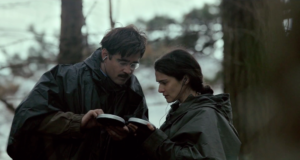 In both The Lobster and Never Let Me Go, the couples are now tasked with proving that what binds them together is true and worthy of the opportunity for life. Their evidence, however, is merely tangible. For Tommy and Kathy, it’s art, and for David and the (formerly) Nearsighted Woman, it’s a shared physical ailment. There is such a heavy consequence that lies at the feet of surface characteristics in both of these fictional worlds. Their lives literally depend on it. It’s not so different from the norms of our non-fictional world. But how can the concept of love–not just romantic love–be so successfully analyzed, examined and dictated? Though the products of mankind’s creativity produce an explicit impact on their consumers, I’m not sure that the inspiration of art could be deemed null and void if the art had never been created or if a connection can be canceled solely due to individual change. Perhaps what Lanthimos and Romanek are really asking their audience is far more basic than we would presume: what is love? Is it a function; an establishment that exists to provide systematic balance in life? If it is more than that, how beneficial could it be when its greatest rewards are deposited in our most helpless situations? Neither filmmaker offers a succinct conclusion in their film’s final act. Instead, they afford the viewer the opportunity to ponder the mysteries that they’ve conjured. Perhaps this is exactly what love is: a mystery left intentionally ambiguous, yet ever compelling.
In both The Lobster and Never Let Me Go, the couples are now tasked with proving that what binds them together is true and worthy of the opportunity for life. Their evidence, however, is merely tangible. For Tommy and Kathy, it’s art, and for David and the (formerly) Nearsighted Woman, it’s a shared physical ailment. There is such a heavy consequence that lies at the feet of surface characteristics in both of these fictional worlds. Their lives literally depend on it. It’s not so different from the norms of our non-fictional world. But how can the concept of love–not just romantic love–be so successfully analyzed, examined and dictated? Though the products of mankind’s creativity produce an explicit impact on their consumers, I’m not sure that the inspiration of art could be deemed null and void if the art had never been created or if a connection can be canceled solely due to individual change. Perhaps what Lanthimos and Romanek are really asking their audience is far more basic than we would presume: what is love? Is it a function; an establishment that exists to provide systematic balance in life? If it is more than that, how beneficial could it be when its greatest rewards are deposited in our most helpless situations? Neither filmmaker offers a succinct conclusion in their film’s final act. Instead, they afford the viewer the opportunity to ponder the mysteries that they’ve conjured. Perhaps this is exactly what love is: a mystery left intentionally ambiguous, yet ever compelling.
Joe Nooft currently resides in Orlando, Fl, where he tests software for a living. A graduate from the University of Central Florida, Joe studied interpersonal, organizational communications and cinema studies. He’s a firm believer that we’re “going to need a bigger boat.” You can follow his thoughts on Twitter: @joenooft


